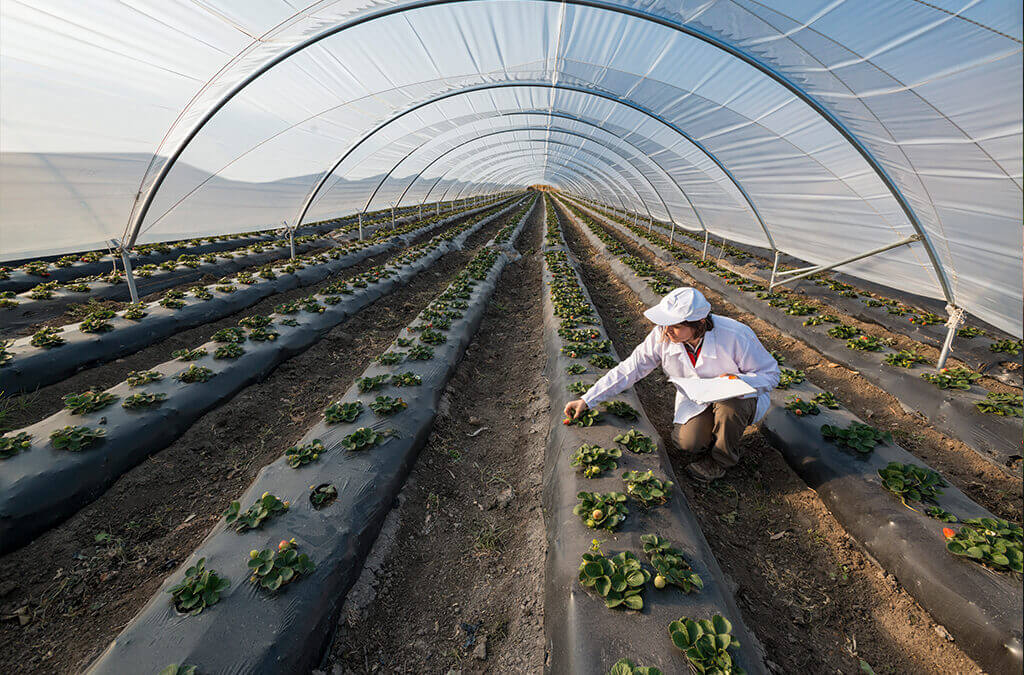Drip irrigation is an efficient crop irrigation system, but it depends on effective water treatment to ensure clean driplines.
Continuous dosing with a proven water treatment chemical will keep driplines clean, ensuring the ongoing effectiveness of a drip irrigation system.
What is Drip Irrigation?
Drip irrigation is a highly controlled process, involving the slow application of water onto the root zone of crops specifically.
This is a way of optimising and directing the water content, instead of irrigating the entire field surface.
In a drip irrigation system, the water drips, one drop at a time, through small emitters.
There are different types of emitter, which work with different drip irrigation systems:
- Drip bubbler systems (point-source emitters)
- Basin bubblers
- In-line drip emitters
- Micro-spray sprinklers.
The emitters control the rate and quantity of water that the drip irrigation system discharges.
These systems only irrigate a portion of the soil, but how much will depend on the characteristics of the soil, the period of irrigation required, how much the emitters discharge, and how many there are in the system.
What Are the Advantages of Drip Irrigation?
Drip irrigation is an efficient water-management system for agriculture. These systems create no pollution, and no run-off. There is also very little evapotranspiration – loss of water from soil by evaporation, and from leaves by transpiration.
As a form of trickle irrigation, it allows farmers to use lower-volume water sources, and require less than half the water required in sprinkler irrigation.
There are less energy costs involved in pumping the water, because it runs on lower operating pressures.
It helps maximise water efficiency, because it can supply water to plants more precisely.
Along with significant water savings, there is better weed control, with the water only being applied to the root zone of crops.
It allows you to continue other field operations such as harvesting during irrigation, because the areas between rows of crops remain dry.
The system can also apply fertilisers and pesticides efficiently.
It is easy to install and manage. You can switch it off in wet weather, to prevent over-irrigation, and you can maintain soil moisture levels with a high degree of precision.
Drip irrigation is adaptable for use on a wide range of terrain, soil and types of crop.
What Makes Drip Irrigation Different to Surface Irrigation?
Surface irrigation is a system that dates back to ancient times. It’s a simple and easy system to manage.
You simply apply water to a field through open channels and pipelines. Water flows across the surface, covering the entire area that is being irrigated.
Afterwards, there will be ponds on the field’s surface, which will drain away or infiltrate the soil.
Surface irrigation systems have a low initial cost, but they offer a blanket solution to irrigation, and they are an inefficient use of water.
Drip irrigation, on the other hand, is both focused and efficient. It provides water to plants and crops according to their requirements, and enables close soil management, to help prevent pests and disease.
It is an ideal irrigation solution for crops growing in dry, low saline and low drainage soils.
Drip irrigation is a form of smart irrigation, applying just the right amount and rate of water.
Why Is it Important to Maintain Drip Irrigation Systems?
Although drip irrigation is both efficient and effective, it does require a good level of maintenance to make sure driplines are clear.
The most serious threat to a drip irrigation is clogging. This is where biological, chemical and physical contaminants build up in the system’s emitters.
Therefore, routine maintenance checks are essential, with regular cleaning of filters and periodic flushing of driplines.
Another key aspect of this maintenance is water treatment, to help minimise the risk of clogging.
How Oxyl-Pro Agro Can Be Beneficial to Driplines
Specialist water treatment can dissolve mineral deposits and remove organic contaminants in water supply lines.
Oxyl-Pro Agro is a water treatment that uses only food-safe ingredients and destroys harmful micro-organisms in water supplies.
Its effect is mild and long-lasting and leaves no residues. It prevents the biofilm build-up in driplines that leads to colonisation by micro-organisms and clogging of systems.
Oxyl-Pro Agro improves overall hygiene levels, while keeping driplines clean and, with continuous dosing, provides extra oxygen to plant roots.
And where you require complete disinfection, you can apply Oxyl-Pro Agro as a shock treatment.
For more information about Oxyl-Pro Agro, and our complete product range, please complete our contact form, call us on +44 1606 851 782, or email enquiries@oxylpro.com

